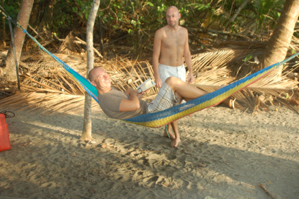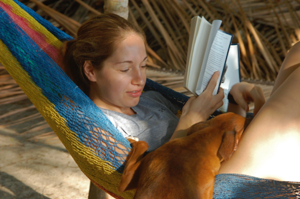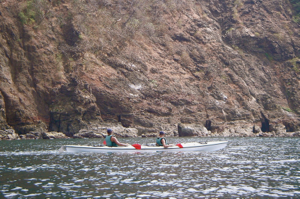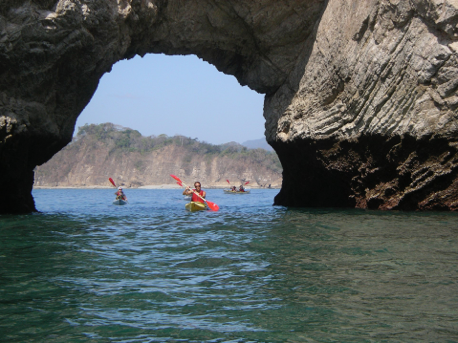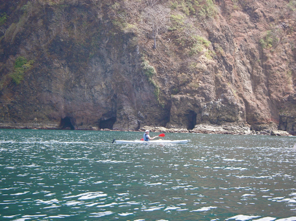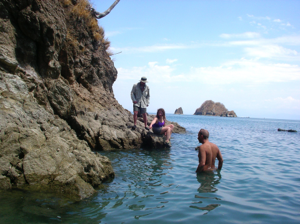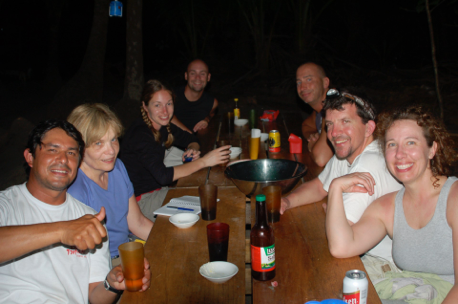Day 3: Another early morning. Up at 6 AM and out to the beach with my camera. I can hear the Howlers, but they are much farther away than they were yesterday. It’s another beautiful day in the tropics! Today I walk south along the beach. I haven’t gone this direction past our kayak launch point. I decide to walk along the top of the beach near the highest high tide mark, beach combing.
I see some of the stuff you typically find on beaches all over the world: plastic bags, plastic bottles, plastic rope, etc. What I don’t find are tar balls; heavy oil expelled from ocean going ships that settles to the bottom and eventually makes its way to shore as hard, thick, sticky tar that gets on your feet and into your shoes. It is very hard to remove. Perhaps this place is further off the beaten track than I thought!
As I walked, I noticed openings in the jungle that exposed another campsite and a few small individual cabins. I learned that the Curu Preserve has several small cabins for rent. They appear quite remote and private. Soon I saw tracks in the sand. They came from the jungle and ran parallel to my track, sometimes on the beach, sometimes in the rough just above. My best guess is that they were the tracks of a monkey. But why would a solitary monkey leave the safety of the trees for an early morning stroll on the beach? It didn’t make sense. Perhaps it was a Coati, looking for a breakfast of fiddler crabs. It’s a mystery unsolved!
When I got back to the campsite, coffee was ready, excellent as always, and with those fine Costa Rican Ho-Hos. I think I had two that morning! Chris, Michelle and Matthew, along with Louis from the crew were at the picnic table when I arrived. Matthew soon retired to a hammock to read until breakfast. Cheryl emerged from her tent and quietly joined him in an adjoining hammock. She was attended to by her canine friend, whom she named Patas Blancos (White Paws), for obvious reasons.
Patas Blancos was one of four dogs that wandered in and out of camp throughout our stay. We think they were loosely connected to Curu’s caretakers. The traveler’s guide book warns that dogs in Costa Rica are often wild and/or are not cared for in the way North Americans expect. They may be flea ridden or suffer from a variety of nasty parasites, or skin conditions such as mange. The advice is to avoid all contact with them. In fact, one of the dogs had what looked like mange or some other nasty skin condition. However, all of the dogs had sweet dispositions and were hard to ignore. This was especially true of Patas Blancos, who soon became Cheryl’s favorite.
We all noticed that Patas Blancos scratched at his left ear repeatedly. We guessed that he might have ear mites, a common affliction in dogs. Cheryl (an EMT) and Michelle (a former CSI) teamed up to swab his ear with alcohol. This seemed to relieve his scratching quit a bit, a small humanitarian gesture to a sweet animal that no one will ever really know about.
Breakfast was at the usual time with the gallo pinto, plantains, eggs and fruit we have come to expect. Sometime around 9 AM we headed for the boats to get ready for today’s trip. This would be the longest paddle of the adventure. We were to paddle around Isla Tortuga, with a rest, play and snack period on a beach at Isla Tolinga. Are these locations beginning to sound too familiar? Each day’s paddling has been essentially, “variations on a theme”, with our group covering all sides of these two islands. But, right now, who cares? It’s warm, it’s beautiful, it’s February and we are paddling in the tropical Pacific Ocean!
Matthew and Jason switch boats for a third time, this time taking the last double kayak. We head out, covering the same Curu Bay territory we have covered on the two previous days. We paddle again to the monolithic rock structure with the large hole to paddle through. Today the tide is lower which gives more overhead space to paddle through, but leaves the rocks to the left in the opening nearly exposed. Everyone but Tarra passes through briskly. Tarra elected to pass by on the outside for reasons that remain unknown. Did yesterday’s incident with the powerboat spook her?
This island, like Isla Tolinga yesterday, is beautiful. There are many shear cliffs and few beaches. The cliffs are studded with sea caves and rock gardens where the island meets the water. After paddling around three sides of Isla Tortuga, we could see Isla Tolinga ahead in the distance. We paddled toward a cluster of two beaches, not knowing which would be our landing place. As we got closer, it appeared that, while both beaches were in full sunlight, one offered a bit more shade than the other. We landed there. We had covered more than 5.5 miles.
The water was warm and inviting. All of us were in it up to our necks almost immediately. This beach was covered with pebbles and very coarse sand, rather than the fine sand we had seen on other beaches. It was narrow, backing up against rocky cliffs that were topped with trees. Some of these trees were deciduous and were leafless like trees at home. This mix of deciduous and tropical trees is known as a transitional forest, as contrasted with a rainforest. The beach ended abruptly at both ends when the cliffs rounded out to meet the water.
Tarra appeared to be asleep, floating on her back. This went on for at least a half-hour! I think this is where her middle of the night “fat lip” misadventure came from (Click here to read Cheryl’s Travelpod blog about Tarra’s “Fat Lip” ). The sun was intense, so I swam with my hat on. This looks cool if you’re young, but goofy if you’re an old goat like me. However, most of my hair has migrated from my head to my back, so I need the protection to keep my pate from developing a severe and painful burn.
The crew quickly had a table set up with food ready for us to snack on. It was a cornucopia of fruit; sweet golden pineapple, watermelon, mango, papaya and more. We feasted, and then drifted off to do what ever pleased us. Some returned to the water, some sought the shade, some beach combed, and some like our Montanans, Michelle and Chris, waded around a large rock monolith looking for anything interesting that they might find.
Michelle is a trained scientist. She worked as a CSI (Crime Scene Investigator) for many years and is now doing genetic analyses for a Montana genetics company. A curiosity about the world that surrounds her seems to be part of who she is. One of the first things I noticed about her was her early morning walks on the beach. You would see her and Chris periodically bending over or squatting to examine something. I can still see her turning something over in her hand, and examining it from all sides before returning it to the beach. She and Chris kept a few small shells as treasures for their kids, after being sure that all former occupants had left.
After climbing up on the rock’s lip, Michelle spotted a large ray slowly moving at its base. Several of us who were in the water moved closer to get a look, while still staying at a safe distance. We tracked this creature for some time before it tired of our pursuit and disappeared.
Soon it was time to launch the kayaks for the trip back to Curu for lunch and an afternoon hike. The paddle back was pleasant. Lisa and I got into a good rhythm, increasing our average speed to 3.4 mph, with one burst of speed that exceeded 5.2 mph. I stayed on the beach to help boats land. Tarra, a.k.a. “Amazon Woman”, asked Cris if he would teacher her to roll her kayak. Cris deferred to Carlos, the youngest of our guides and an expert white water paddler. We rigged her with a spray deck while Carlos demonstrated the roll several times. Three of us positioned ourselves around Tarra’s boat while she capsized and tried to roll back up. She came close, but never made it. Carlos made it look easy, but it’s not. Trying to figure out where all your body parts are supposed to be while sweeping your paddle upside down and trying to roll the boat upright takes a lot of coordination and practice. Matthew tried next, then I tried with about the same level of success.
We had to quit because lunch was ready. I don’t remember specifically what it was, but I know I never had a bad meal while there. After lunch, folks relaxed, read, played cards and walked on the beach. At three o’clock, Cris gathered those of us who wanted to hike on the trails through Curu Preserve, and we started off.
It was very still in the forest. This was a transitional forest, meaning it was partly rainforest and partly a dry, deciduous forest. So while there were mostly palm and other tropical forest plants, there were also some dry forest trees mixed in. When looking for wildlife, it seems that you walk softly for a long time and see nothing. Then your eye catches some movement. You search and see a Howler Monkey, high up, jumping from tree to tree. You hear a rustling in the dry leaves just off the trail and freeze. There on the side of a small hill is an Agouti, a small rodent a little bigger than the largest rabbit, foraging for dinner. You notice that the narrow leaves of a forest palm have been partially cut through. Looking underneath the leaf you find a white tent bat sleeping in the fold where the leaf has been cut. You scan the trees with your binoculars and spot a large green parrot in the very top of a large tree, silhouetted against the sky. A beautiful blue butterfly lands on a plant illuminated by the rare shaft of sunlight that penetrates to the forest floor. You stop to admire it, but it is off on its journey all too soon. In a meadow standing under a large tree in knee deep grass is a large white tailed deer, common at home, but very rare here. It’s a buck with a large developing rack in full velvet. He stands and we stare at each other for the longest time before moving on. Patience pays in the forest. Your reward is seeing these creatures where nature has placed them. Not in some zoo, not in a book or a Discovery Channel documentary, but in the wild, in their home.
Between our final Happy Hour and dinner, the gas lights started to go out. Louis got new fuel canisters and began to relight them, one-by-one. In removing and replacing the canister from one light, he grabbed a hot metal chimney plate and burned himself. His right thumb and index finger began to blister. CSI Michelle and EMT Cheryl came to the rescue with ice and bandages.
After dinner, Jason led several members of the group in line dancing. This was comical because the only music source was an iPod. The earpieces were shared by two people, while the rest just tried to follow along.
Then there are the No-see’ums! These little guys are nearly invisible, but pack a terrific bite. You find yourself slapping at an arm or leg and yelling, “Something’s biting me, but I can’t see it!” Thus the name, No-see’um. These pests were around every night for an hour or two. Matthew and Jason were always prepared with DEET. I, on the other hand, hate that stuff. And while I find the No-see’ums annoying, they leave no lasting mark on me. Not so for Lisa. She also hates to use DEET and she also finds the No-see’ums annoying, but she has a reaction to them, with each bite swelling into its own intensely itchy spot. By the end of this evening, her arms, legs, neck and face were riddled. She looked like she had chicken pox. Her eyes even began to swell – it wasn’t pretty. And yet, she can leave the jungle and honestly tell everyone she meets that she had a wonderful time. You’ve just got to love a woman like that!
On the beach, the stars were very intense. With no ambient light from nearby cities or resorts, we could see the full array of stars. The last time I saw a light show like that was 8,000 feet up a mountain in Yosemite National Park. This night we stumbled over Tarra, who had gone to the beach to escape the No-see’ums. She was wrapped in a blanket, asleep. It scared the snot out of us! She looked like the victim of some capital crime. Too soon it was off to bed, knowing that this was our last night at Curu Preserve.
Clockwise: Louis, Lisa, Cheryl, Jason, Matthew, Chris, Michelle

